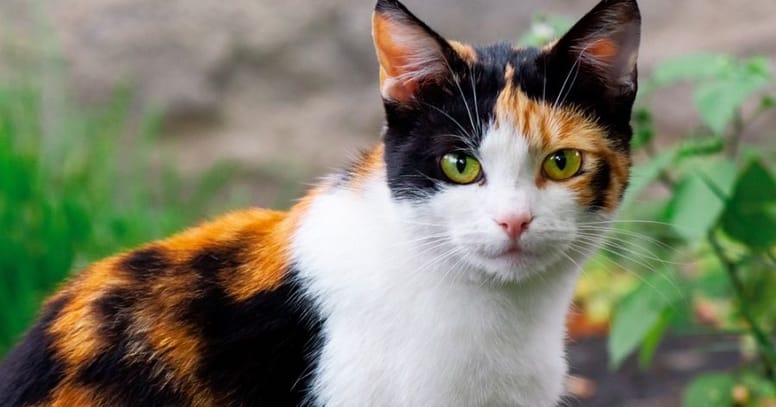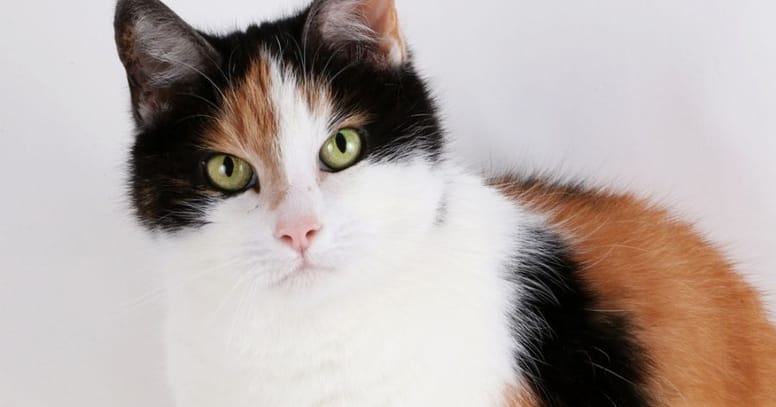Have you ever heard of the calico cat? You've probably seen one walking down the street, sleeping in a quiet garden or watching passers-by from a windowsill, if you don't have one yourself. The calico cat is not a breed; it is simply a cat with a tricolour coat of white, orange and brown.
Where does this original coat come from? What are its origins? Is it true that there are only calico females? What are the legends surrounding this mysterious feline? Let's discover some of the calico cat’s secrets...
How do I recognise a calico cat?
Calicos are often described as the most colourful cats in the world. After all, they are one of the only cats to have such a wide range of colour variations in their coats.
The most common calico coat is a three-colour pattern with orange, black and white colours. However, it is possible to have a calico pattern with shades of cream, red, blue-black and even chocolate brown. Calicoes with less intense colouring are called diluted calicoes. They are mainly white with light coloured spots ranging from blue-grey to cream to strawberry blond.

Are all calico cats female?
It is important to know that about 99.9% of calico cats are female. Why is this? The reason is simply genetic. The specific coat colour is linked to the sex of the animal.
Let’s get more into biology. In each cat cell there are 19 pairs of chromosomes, one passed on by the father, the other by the mother within each pair. Each chromosome contains alleles that determine the colour of the cat’s coat, but also the colour of the eyes and the size of the animal.
In cats, females have XX sex chromosomes, while males have XY sex chromosomes. The calico coat is possibly made when one of the two X chromosomes of the female is inactive. The same genetic anomaly is responsible for the tortoiseshell coat, also random and unique, resulting from a similar unpredictable mutation.
Furthermore, sex can be explained by colours and vice versa. Indeed, we have said that females have cells containing two X chromosomes. The orange colour of cats is only possible because of a gene in the X chromosome. The white colour alone is caused by the S gene, an autosome that causes the coat to form lighter or darker spots. Furthermore, the fact that a cat has both white and brown (or black) on its coat is only possible for an animal with two X-chromosomes. However, the X-chromosome can be passed on by the mother or the father, the latter having XY-chromosomes.
To put it simply, females have two X chromosomes, which allow them to pass on both black and orange to their kittens. Males, on the other hand, have only one X chromosome, so they can pass on either black or orange to their kittens, but not both. The Y-chromosome has no influence on the colour of the coat, it is only used to determine the sex of a kitten.
In addition to this already complex pattern, there are also gene traits. The main gene responsible for the coat colour of cats is the B gene. This gene can be B, i.e. dominant, which means that it will have a greater influence, or B, i.e. recessive, which means that it is masked by the dominant gene. For example, gene B gives the colour black and gene b gives a chocolate colour. The expression of gene B can be influenced by the presence of other genes on other chromosomes. The colour orange, for example, comes from the O gene. However, while the O gene (dominant) can influence B, the o gene (recessive) cannot.
Thus, to obtain a calico cat, it is important that the dominant gene is the determinant of the orange colour against the black colour and that the S gene, a non-sexual chromosome, is active in determining the white spots.
How rare is a calico cat?
A male calico cat is extremely rare. Indeed, it is easy to see how difficult it is to get a calico cat! The very few calico males are therefore the result of a double genetic mutation, which may explain their sterility.
Since almost 99.9% of calico cats are female, this means that about 0.01% of these unusual cats are male. In reality, there is only 1 male calico in every 3,000 tricoloured cats. On the other hand, only 1 in 10,000 calico males is fertile. The overwhelming proportion of sterile calico males, considering their very small numbers, partly explains the large dominance of tricolour females.
Which cat breeds can have a calico coat colour?
This does not only affect domestic short-haired cats, but also other breeds, some of which allow the calico colour in their standards.
This is the case of the Isle of Man cat, the American Shorthair, the Maine Coon, the British Shorthair, the Persian cat, the Arabian Mau, the Japanese Bobtail, the Exotic Shorthair, the Siberian, the Turkish Van, the Turkish Angora or the Norwegian Forest cat.

Origins and history of the calico cat
As calico cats are relatively rare and their births are random, many legends circulate about their origins. Calicos already existed in Ancient Egypt, several remains of these tricoloured animals having been found. They have been attributed magical powers for centuries and Japanese sailors liked to keep them on their ships; these cats were reputed to protect crews during storms and to chase away evil spirits.
A 12th century Tibetan legend tells of a monastery that took in a female calico and her kittens, seeing their sudden arrival as a divine sign at a time of crisis for the monks. Gradually, these tricoloured cats became more and more important in the life of the monastery. The monks saw them as symbols; white and black embody Yin and Yang, the opposing forces that bring balance. The colour orange represents the earth and the home. This cat and her many kittens were seen as symbols of renewal and unity.
In many cultures, these unusual and rare cats have the reputation of bringing good luck. In Germany, they are known as "Glückskatze", which means "good luck charm". In Japan, the popular Maneki-neko statues of a seated cat raising one or two paws to the ears represent calico cats. Their nickname "mi-ke" means triple fur because of the colour of their coat. Many Japanese have one under their roof, the animal being synonymous with good fortune. Finally, in Ireland, legend has it that rubbing a wart against the tail of a Calico cat in May would make it disappear. A number of myths exist around this unusual cat, proving that it knows how to make a name for itself!
Although their origin is still unknown, a study has determined that the proportion of cats with the orange gene (responsible for the calico colour) is much higher in the Mediterranean port cities. Although many breeders have tried to fix it, this colouring is an "accident" that cannot be predicted and therefore cannot be reproduced.
The personality of a calico cat
It is important to understand and remember that the personality of a cat does not depend on its coat colour but on the individual. As the calico cat is not a breed but a coat colour, it would be wrong to generalise the personality of a calico cat. If you have a female domestic short-haired cat with a calico coat, she will have her own personality, not like any other cat. On the other hand, if you have a Maine Coon cat with a calico coat, then her personality will be very similar to her breed’s characteristics.
Like many cats, calicos will develop their unique personalities based on many factors, such as socialisation and life experiences. Because calico cats are so different from each other, it's especially exciting to get one. You might get a laid-back, sweet cat that loves to be in your company and wants to be your loyal companion. Or you might have an aloof cat that doesn’t demand a lot of attention and has an attitude.
That said, many calico owners report that their cats share a personality similar to that of tortoiseshell cats. They are known to be brave, sassy and independent by nature. Calico cats may share these characteristics but, as mentioned, you never really know what you're going to get. Furthermore, calico cats cannot be mated, so they are even less likely to share common characteristics.
How long do calico cats live?
The average life expectancy of calico cats is 12 to 16 years. Is this more or less than the average lifespan of most cat breeds? Yes and no. It depends on whether the calico cat is a male or a female and if the calico cat is a pure breed or not.

Male calico cats tend to live shorter lives than female calico cats due to a genetic condition called Klinefelter's syndrome. This syndrome results in the presence of two X chromosomes and one Y chromosome. Klinefelter's syndrome can lead to many health problems, such as an increased risk of fractures, joint pain and diabetes. These health problems can lead to a shortened life expectancy in male calico cats.
Whether your cat is a male or female calico, you can help your feline have a good quality of life by providing good shelter, nutritious food and quality veterinary care.
What's a good name for a calico cat?
You’ve just welcomed a beautiful calico cat and want to find the perfect name for your new furry best friend? We’ve prepared a list of 20 great names for your calico cat. We hope you’ll find the future name of your cat in this list.
- Abby
- Bella
- Binx
- Boo
- Buttercup
- Harlow
- Honey
- Ginger
- Kiki
- Lucy
- Marble
- Niamh
- Oscar
- Peanut
- Penny
- Pixie
- Roxy
- Sunny
- Truffles
- Zoe

